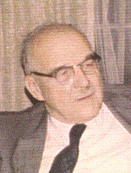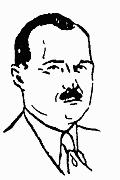 Maurice B. Visscher (August 25, 1901-May 1, 1983) was an internationally recognized physiologist and an outspoken and active citizen. His work as medical researcher and teacher, in linking the science of physiology with the practice of surgery, led to major developments in cardiovascular surgery.
Maurice B. Visscher (August 25, 1901-May 1, 1983) was an internationally recognized physiologist and an outspoken and active citizen. His work as medical researcher and teacher, in linking the science of physiology with the practice of surgery, led to major developments in cardiovascular surgery.
Maurice was born in Holland, Michigan, which had been settled by Calvinists from the Netherlands. His father was a teacher who later became a farmer. In 1922 Maurice graduated from Hope College, a Reformed Church college in his home town, and moved to Minneapolis with a fellowship to study physiology at the University of Minnesota. Before leaving, he became engaged to marry Gertrude Pieters, also a graduate of Hope. In 1925, shortly after he had earned his Ph.D. in physiology, Maurice and Gertrude were married. They had four children.
The next eleven years solidly established Visscher’s career. He did heart-lung research with Ernest Starling at the University of London, 1925-26, and research in physiology under A. J. Carlson at the University of Chicago, 1926. He was assistant professor at the University of Tennessee, 1927-29, then associate professor and chair of the Department of Physiology and Pharmacology at the University of Southern California, 1929-31, where he began ground-breaking research on digestion. During the summers he did the clinical work which enabled him to complete his M.D. degree, 1931. Between 1931-36, while he was chair of the Department of Physiology at the medical school of the University of Illinois, he began using radioactive isotopes to study intestinal absorption.
From 1936 to 1968 Visscher headed the Department of Physiology at the University of Minnesota. Here, he initiated weekly meetings between his physiology department and his friend, Chief of Surgery Owen Wangensteen, and the Department of Surgery, sharing with them his expertise in physiology and information he had learned from contacts in other scientific disciplines. Among other things, Visscher introduced Wangensteen to the mass spectrometer, invented by physicist Alfred Nier during World War II, which Wangensteen adapted to monitor anaesthetic concentration, a measurement critical during long and complicated operations. Visscher was a pioneer in this kind of interdisciplinary collaboration. Innovative heart surgeons Christiaan Barnard, C. Walton Lillehei, and Norman Shumway spent part of their surgical residencies as students in Visscher’s physiology department.
Visscher published papers on a wide range of medical subjects, including cancer, aging, nutrition, high blood pressure, kidney function and circadian rhythms. He served as president of the American Physiological Society, 1948-49, and was elected to membership in the National Academy of Sciences, 1956.
Believing that “unfettered scientific inquiry” may require “rejection of the values of yesterday,” Visscher abandoned the Calvinism of his youth. In 1934 Visscher signed the membership book at the Third Unitarian Church of Chicago. The minister, Edwin H. Wilson, a signer of the “Humanist Manifesto,” later edited the Humanist. Shortly after his return to Minnesota, Visscher joined the First Unitarian Society of Minneapolis. The minister there, John H. Dietrich, was, like Wilson, a prominent humanist. Other ministers during Visscher’s years include Raymond B. Bragg, Carl Storm, Robert Lehman, and Khoren Arisian. Visscher served on the Minneapolis church board, 1937-47, again in the 50s, and as chairman of the ministerial search committee in 1965. Visscher was an outspoken Humanist. From 1942-54 he had a regular column in the Humanist called “Science and Society.” He signed Humanist Manifesto II in 1973.
 Much of Visscher’s social activism grew out of his work as a scientist. He was a strong advocate of academic freedom, free speech, and the international exchange of learning. He openly opposed McCarthyism and loyalty oaths. He supported use of animals in medical research, which he thought necessary to scientific progress. He revived the periodical Biological Abstracts to promote the dissemination of new knowledge. He served as Secretary General of the International Union of Physiological Sciences; as President, for a decade, of the National Society for Medical Research; and as the first chairman of the American Association for Accreditation of Laboratory Animal Care.
Much of Visscher’s social activism grew out of his work as a scientist. He was a strong advocate of academic freedom, free speech, and the international exchange of learning. He openly opposed McCarthyism and loyalty oaths. He supported use of animals in medical research, which he thought necessary to scientific progress. He revived the periodical Biological Abstracts to promote the dissemination of new knowledge. He served as Secretary General of the International Union of Physiological Sciences; as President, for a decade, of the National Society for Medical Research; and as the first chairman of the American Association for Accreditation of Laboratory Animal Care.
During World War II, as a board member of the Unitarian Service Committee, Visscher proposed a series of medical missions to Europe. The first of these was organized in 1945. He led the 1947 medical mission to Austria, and recruited outstanding scientists to donate their time to other missions to Europe and Asia. In Austria Visscher lectured at the universities in Graz, Innsbruck, and Vienna on a variety of topics, including heart failure, high blood pressure, cancer, intestinal absorption, and the effects of famine.
Visscher’s work with isotopes in physiology, together with his Democratic politics, led Minnesota governor Orville Freeman, in 1957, to appoint him to a committee where Visscher looked at the effect of atmospheric nuclear testing on milk produced by Minnesota cows. This work provided a scientific foundation for the ban on atmospheric nuclear testing.
In the 1950s, when the American Medical Association opposed pre-paid medical care, Visscher volunteered his time as medical advisor to Group Health. He brought together leaders of the local chapters of the AMA to consider the subject. Although he didn’t receive their blessing, he did obtain an agreement that they would not oppose the hospital accreditation of Group Health doctors.
Visscher was never afraid or embarrassed to stand alone. In 1967 when Minnesotans against the War in Vietnam placed a half-page national advertisement in the Minneapolis Star-Tribune, only the chair of the group placing it was named: M. B. Visscher. Senator Hubert H. Humphrey, long-time friend, with whom Visscher disagreed about Vietnam, is quoted as saying: “Maurice Visscher is a man respected for his professional excellence, an outstanding teacher, a long-time friend who is deeply concerned about the social, economic and political conditions of our society. He is a political activist who is able to blend the excellence of his professional ability with his outrage against any form of injustice. Those of us in political life know him as fiercely independent and always persevering.”
In 1979 Visscher addressed the American Physiological Society on the subject: “Fifty Years as Scientist and Citizen.” At the end of this speech to other scientists, he concluded by saying:
“. . . first of all, pay attention to your scientific creativity and productivity. But also remember that you live in a society as I have in which there are many acute problems in which your scientific expertise may help society solve its problems and, perhaps not less important, in which the ethic of truthfulness which is at the heart of the scientific method may be infused into societal decisions.”
Information on Maurice Visscher can be found in the archives of the University of Minnesota, Minneapolis, Minnesota; the archives of the Unitarian Service Committee at Andover-Harvard Theological School, Cambridge, Massachusetts; the records of the First Unitarian Society of Minneapolis, Minneapolis, Minnesota and the Third Unitarian Church of Chicago, Chicago, Illinois; the Joint Archives of Holland, Michigan; the records of Ottawa County, Grand Haven, Michigan; and the records of the Keohane and Visscher families. Visscher wrote Experimental Physiology (with Paul W. Smith, 1935); Humanistic Perspectives in Medical Ethics (1972); Ethical Constraints and Imperatives in Medical Research (1975); “Frank Charles Mann,” National Academy of Sciences, Biographical Memoirs (1965); and was author or co-author of more than 200 published research papers. He edited Chemistry and Medicine (1939) and Claude Bernard and Experimental Medicine (1967) and initiated the Handbooks of Physiology (1966). A number of Visscher’s articles are available on the internet.
Biographical articles on Visscher include Tom Patterson, “Maurice Visscher,” Minnesota Medical Bulletin (Winter 1977); Horace W. Davenport, “Maurice Bolks Visscher,” National Academy of Sciences, Biographical Memoirs (1993); Michelle E. Osborn, “Visscher, Maurice Bolks,” American National Biography (1999), and Visscher’s autobiographical entries in Who’s Who in America. N.B. Despite the titles of some of these articles, Visscher has no middle name, only a middle initial. For background on Visscher’s contributions to heart surgery see G. Wayne Miller, King of Hearts (2000). For more on Visscher’s politics consult with caution Alpha Smaby, Political Upheaval: Minnesota and the Vietnam Anti-war Protest (1987). Ghanda Difiglia, Roots and Visions: the First Fifty Years of the Unitarian Universalist Service Committee (1990) discusses Visscher’s role in organizing the post-war medical missions to Europe. An Enduring Mission: The Story of Group Health (1991) includes information on his 23 years as chairman of the medical advisory board of a successful early HMO.
Article by John Keohane
Posted December 14, 2001